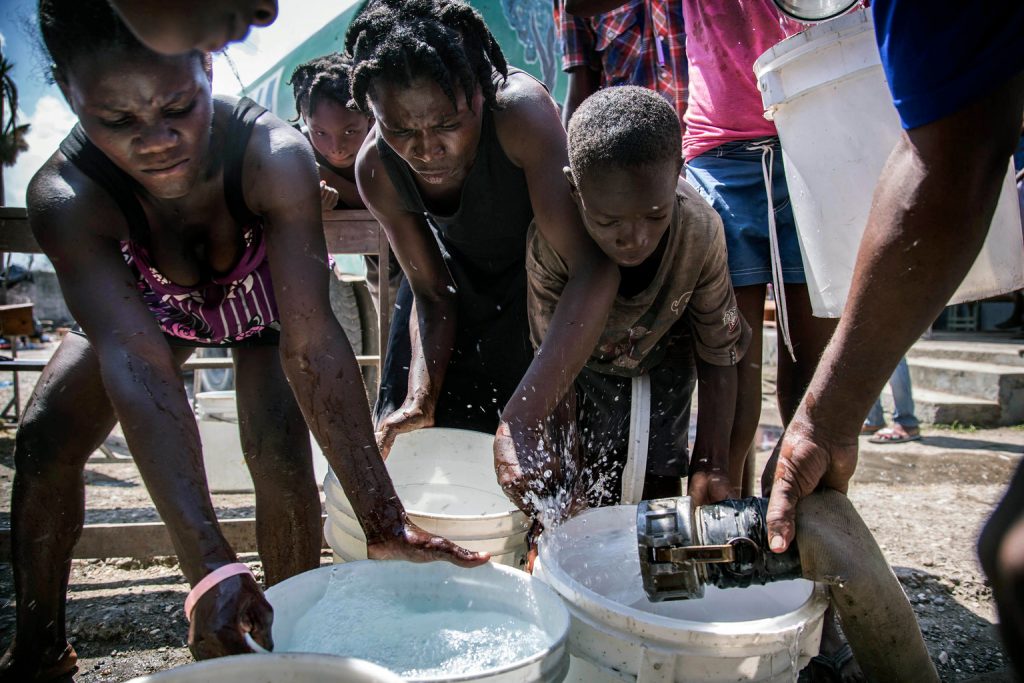In 2016, after six years of cholera epidemics in Haiti, the United Nations Children’s Fund (UNICEF) implemented a multisectoral operational research programme in four urban cholera hotspots. These hotspots were known to have recurrent transmission of the disease, and therefore play a role of ‘source’. The research featured in this SSHAP Case Study aimed to identify, at neighbourhood level, the root causes of cholera, and to design appropriate action plans.

UNICEF/LeMoyne
On 12 October 2016 in Jérémie, Haiti, women and children fill buckets with clean water. A tanker truck in the area provides chlorine-treated spring water to temporary shelters for the displaced. ACTED, a UNICEF implementing NGO-partner, is working in partnership with the national water branch, DINEPA, to ensure the purification of the water delivered.
Hurricane Matthew passed over Haiti on Tuesday October 4, 2016, with heavy rains and winds. While the capital Port au Prince was mostly spared from the full strength of the class 4 hurricane, the western area of Grand Anse, however was in the direct path. The cities of Les Cayes and Jeremie received the full force sustaining wind and water damage across wide areas. Coastal towns were severely damaged as were many homes in remote mountainous regions. International relief efforts are underway to provide food water and shelter to the people affected by the storm.
An estimated 500,000 children live in the Grande Anse Department and Grand South Department in southern Haiti, the areas worst hit by Hurricane Matthew. UNICEF had prepositioned emergency supplies with national authorities to reach up to 10,000 people. On 8 October, six water trucks arrived in Jeremie and Les Cayes, the respective capital cities within the Departments. Additional water and sanitation supplies, such as water purification tablets, water bladders and plastic sheeting, have been dispatched to the most affected departments in the westernmost tip of Haiti. As of 10 October, UNICEF delivered blankets, buckets, water purifying equipment and cholera diagnostic kits. UNICEF is working to reinforce good hygiene practices, especially in temporary shelters, in order to minimize the outbreak of disease. An investigation is underway to confirm the areas affected by cholera, and to determine the cross-over with hurricane-affected areas.
Related content
Infographics
Key Considerations: Child Engagement in the Context of Disease Outbreaks in Eastern and Southern Africa
This infographic summarises the insights from a recent key considerations brief on child engagement in the context of disease outbreaks in Eastern and Southern Africa. This brief explores why, when and how to engage children in the prevention, response and…
Central and East Africa Hub
SSHAP
2024
Infographics
Key Considerations for Responding to Floods in South Sudan Through the Humanitarian-Peace-Development Nexus
This infographic summarises the insights from a recent key considerations brief on responding to floods in South Sudan through the lens of Humanitarian-Peace-Development (HDP) Nexus. The brief describes the multidimensional impacts of flooding on peace, health, livelihoods and governance and…
Central and East Africa Hub
SSHAP
2024
Briefing
Key Considerations: Child Engagement in the Context of Disease Outbreaks in Eastern and Southern Africa
Effective child engagement strategies are essential to optimise the response to disease outbreaks and minimise their impact while ensuring children’s protection, well-being and resilience. When children understand disease outbreaks, they are better able to cope, contribute and recover. This promotes…
Central and East Africa Hub
SSHAP
2024
Briefing
Key Considerations for Responding to Floods in South Sudan Through the Humanitarian-Peace-Development Nexus
In common with many other African countries, the Republic of South Sudan is increasingly experiencing devastating floods linked to climate change.1,2 The Indian Ocean Dipole (IOD) and El Niño regulate the climate of Equatorial Eastern Africa. In 2019, a dipole…
Central and East Africa Hub
SSHAP
2024


